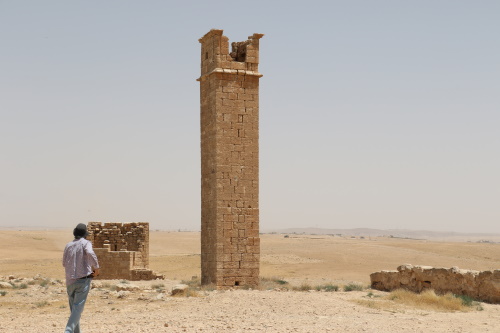Community Luncheon and St. Symeon the Stylite
Community Luncheon on Thursday, September 12, 2019 at 12:00pm

Our next Community Luncheon will be held on Thursday, September 12.
Menu
Stuffed Baked Tomato
Greek Salad with Feta and Kalamata Olives
Dessert
Barbara Dionysopoulos and friends are preparing a delicious meal for all our members. Come and join us to enjoy some good food and the company of your friends. Make some new friends too and get to know other parishioners.
Reservations are required! Please call Barbara at 239-826-1655 or sign up in the Social Hall after Divine Liturgy.
Donations are accepted. Proceeds benefit the building fund.
St. Symeon the Stylite

Last Sunday we talked a bit about St. Symeon the Stylite, the man who lived on a pillar for 47 years spending most of his time in prayer.
As it happens, Steve and Anne Breitenbach visited Jordan recently and saw the place where St. Symeon lived. They sent these pictures and commentary.
Regarding our talk in church last about stylite towers, I thought these pictures would help tell the story. Anne and I visited Israel and Jordan this year. The attached photos are from a ancient town called “Castron Mephaa”. You can see the Greek lettered name in the floor mosaic tiles in the detail picture – along with a mosaic of the Stylite the site is famous for.
Today the location is called Umm ar-Rasas – “The Mother of Bullets” – for the Roman Army garrison that it was back in the days prior to the Muslim conquest. Mephaa is believed to be the town of Mephaat, called out in the book of Jereremiah. Castron I think comes from the Roman Latin for fortified military camp. This area is about 30km southeast of Madaba. There is a LOT of Christian history to see in Jordan — Probably that was the most surprising thing we learned on our trip there!
This location has ruins of LOTS of churches, with the Church of St Stephan the largest. The complete floor mosaic had representations of the major cities east of the Jordan on one side (Our Lord’s side), and the cities west of the Jordan on the other side (our Lady’s side). The mosaics have no iconography as this was built AFTER the Muslim conquest – but interestingly, the Christian community was obviously very robust and affluent even in the mid-700’s. There is an even older 500 AD church under this 700’s AD church.
The stylite tower is one of only a few surviving sytlites remaining. The city represented in the mosaic just below the stylite is “Philadelphia” (in Greek of course), which is today’s city of Amman (Jordan’s capital).
Some pictures from the trip:






